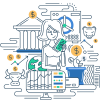Checking Accounts
Checking accounts are bank deposit accounts that provide the account holder the ability to write checks against the balance of funds in the account. These accounts are a primary type of demand deposit and are part of the M1 money supply, which also includes currency in circulation and in bank vaults. In some cases, checking accounts may earn interest when a minimum balance is maintained as specified by the bank.
Key Features
- Check-Writing Privileges: Allows account holders to write checks which can be cashed by the payee.
- Demand Deposit Nature: Funds can be accessed at any time without prior notice.
- Potential for Interest: Some checking accounts offer interest on balances if specific criteria like maintaining a minimum balance are met.
- Debit Card Access: Many checking accounts come with a debit card allowing electronic access to funds.
- Online Banking: Offers convenience with online access to account management and transfer services.
Examples
- Personal Checking Account: Common account used for everyday transactions such as deposits, bill payments, and money transfers.
- Business Checking Account: Designed for business entities, offering additional features like higher transaction limits and integrated payment solutions.
- Interest-Bearing Checking Account: Offers a modest interest rate on deposits as long as a minimum balance is maintained.
Frequently Asked Questions (FAQ)
Q: What is a checking account? A: A checking account is a type of bank deposit account that allows the account holder to write checks and access funds on demand.
Q: How does a checking account differ from a savings account? A: A checking account is primarily used for everyday transactions and allows for immediate access to funds, while a savings account is designed for longer-term deposits with limited transaction capabilities and usually higher interest rates.
Q: Can a checking account earn interest? A: Yes, some checking accounts can earn interest if certain conditions, such as maintaining a minimum balance, are met.
Q: Is there a limit on the number of checks I can write from a checking account? A: While many banks do not impose a strict limit, some checking accounts may have restrictions on the number of transactions that can be made each month.
Q: What fees are associated with checking accounts? A: Common fees include monthly maintenance fees, overdraft fees, ATM fees, and fees for writing more checks than allowed by the account terms.
Related Terms
- Demand Deposit: A type of bank account from which funds can be withdrawn at any time without any notice, typically including checking and savings accounts.
- M1 Money Supply: The most liquid forms of money, which includes physical currency, demand deposits, traveler’s checks, and other checkable deposits.
- Overdraft: An extension of credit from a bank that is triggered when an account holder writes a check or makes a withdrawal exceeding the available balance.
- Debit Card: A card issued by banks to checking account holders that allows for the electronic transfer of funds from the account when a purchase is made.
- Online Banking: A service provided by banks allowing account holders to manage their accounts, transfer funds, and pay bills via the internet.
Online References
Suggested Books for Further Studies
- “Banking Basics: A Financial Literacy Primer” by Paul J. Christopher
- “The Everything Budgeting Book” by Tere Stouffer
- “Personal Finance For Dummies” by Eric Tyson
- “The Only Guide to a Winning Investment Strategy You’ll Ever Need” by Larry E. Swedroe
- “Understanding Investments” by Charles Beelaerts
Fundamentals of Checking Accounts: Finance Basics Quiz
Thank you for diving deeper into the world of checking accounts, exploring their fundamental features, and testing your newfound knowledge with our quiz! Stay informed and confident in your financial understanding.
